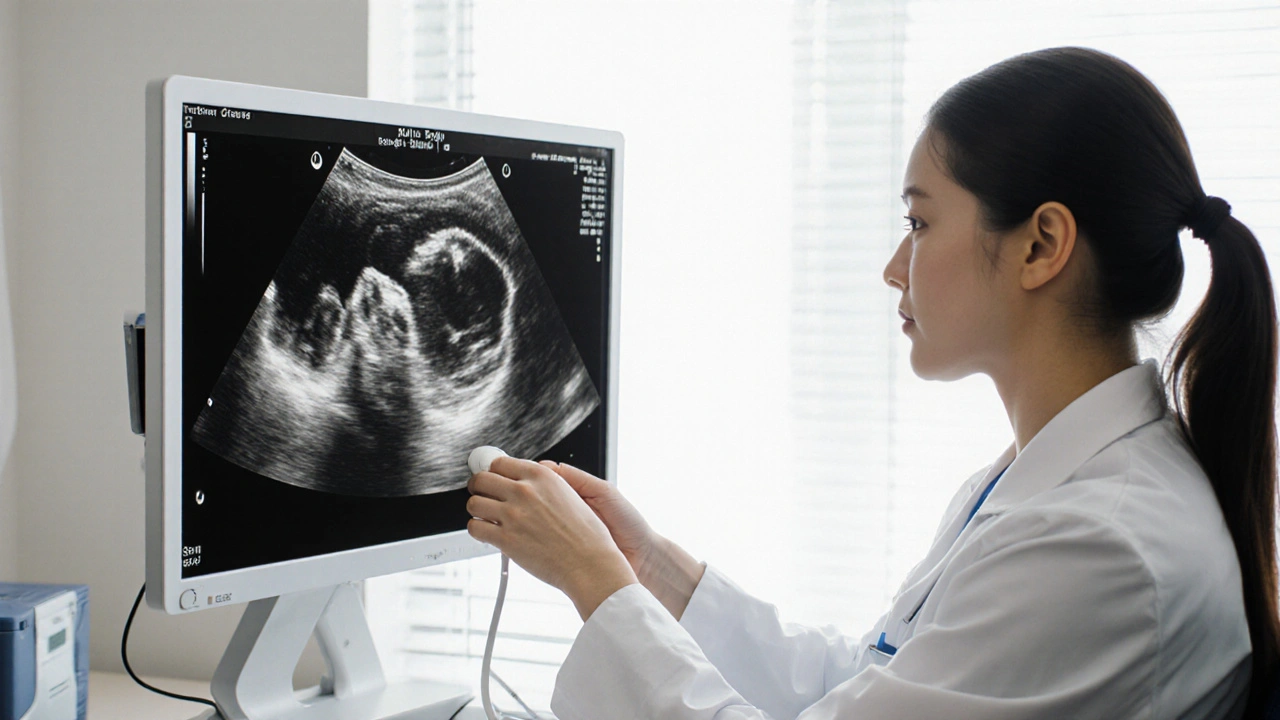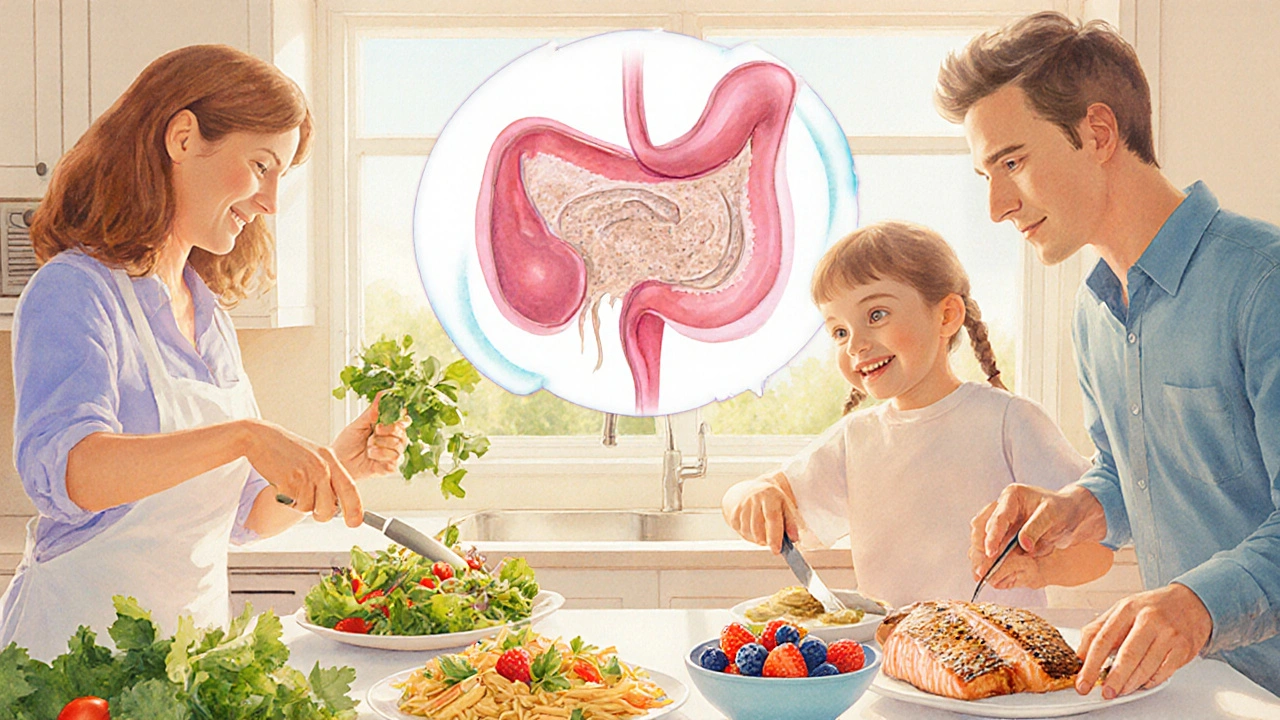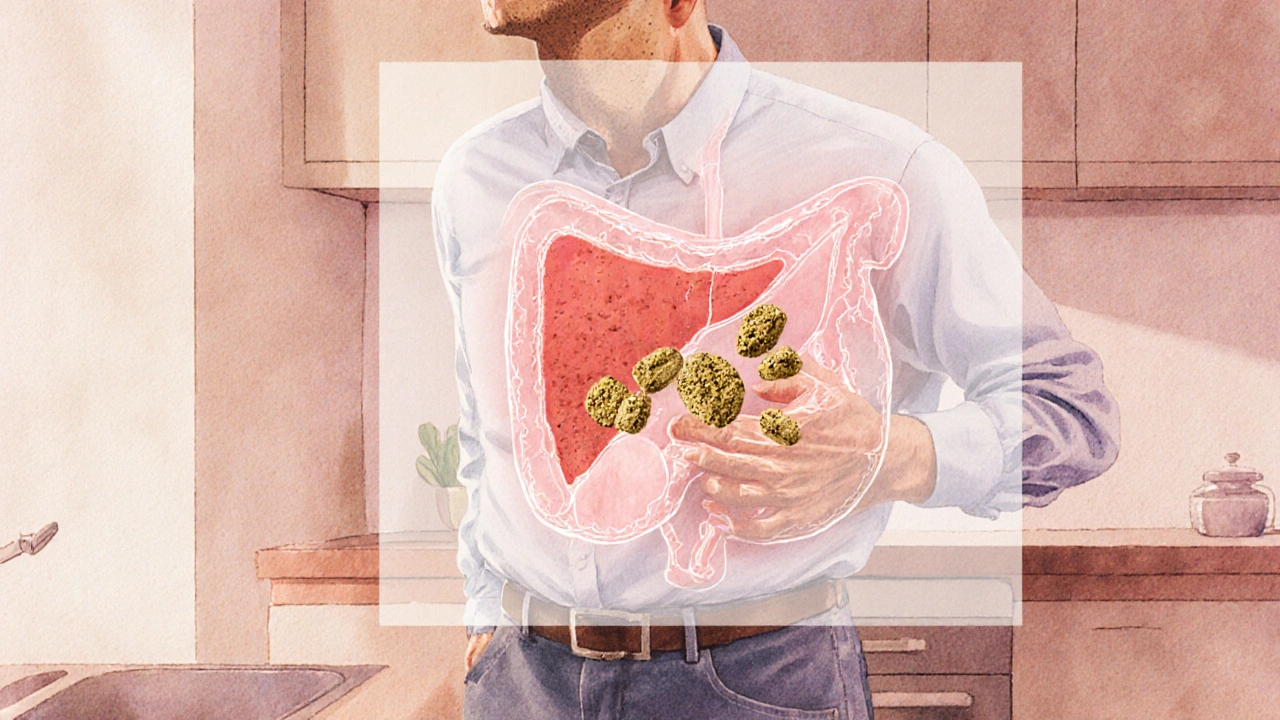Gallstone Symptom Quiz
Answer the following questions to assess whether your epigastric pain might be related to gallstones.
Quick Takeaways
- Epigastric pain often signals a gallstone problem, especially when it spikes after a fatty meal.
- Gallstones are solid deposits that can block bile flow, causing intense discomfort called biliary colic.
- Ultrasound is the go‑to imaging test; MRCP helps when stones hide in the ducts.
- Treatment ranges from watchful waiting to medications like ursodeoxycholic acid, and finally surgery (cholecystectomy).
- Lifestyle tweaks-balanced diet, steady weight, and proper hydration-lower the chance of new stones forming.
When you feel a burning or squeezing sensation right under the breastbone, you might be dealing with epigastric pain. While many things can irritate that spot, a common but often overlooked culprit is Gallstones solid particles that form in the gallbladder from hardened bile, often composed of cholesterol or pigment. Understanding how these two health issues intertwine helps you act fast, avoid complications, and choose the right treatment.
What Is Epigastric Pain?
Epigastric pain discomfort located in the upper central region of the abdomen, just below the sternum can feel like a dull ache, burning, or sharp stabbing. It’s a symptom, not a disease, and can stem from the stomach, pancreas, esophagus, or the biliary system. Because the gallbladder sits right behind the liver and empties into the bile ducts near the duodenum, stones lodged there can easily refer pain to the epigastric zone.
How Gallstones Form and Their Types
Gallstones develop when the ingredients in bile-cholesterol, bilirubin, and salts-become imbalanced. Two main types dominate:
- Cholesterol stones large, yellowish deposits made primarily of hardened cholesterol. They’re linked to high‑fat diets, obesity, and rapid weight loss.
- Pigment stones small, dark stones formed from excess bilirubin, often seen in chronic hemolysis or liver disease.
Both types can stay silent for years. When a stone blocks the cystic duct or common bile duct, pressure builds, and the resulting “biliary colic” often presents as epigastric pain.
Why Gallstones Can Trigger Epigastric Pain
The gallbladder’s job is to store and concentrate bile, releasing it into the bile ducts tiny channels that carry bile from the liver and gallbladder to the small intestine. When a stone wedges into the cystic duct, the gallbladder contracts after a fatty meal, but the bile can’t exit.
This creates a sudden rise in pressure, stretching the gallbladder wall and irritating nearby nerves. Those nerves share pathways with the epigastric region, so the brain interprets the signal as pain high up in the abdomen. The pain often spikes 30minutes to 2hours after eating, lasts 15‑30minutes, and can radiate to the right shoulder or back.

Spotting the Warning Signs
Besides the classic epigastric ache, watch for these clues:
- Nausea or vomiting shortly after meals.
- Fever, chills, or jaundice (yellow skin/eyes) - signals infection or a blocked common bile duct.
- Dark urine or pale stools, indicating bilirubin buildup.
- Sudden relief after “passing” the stone, often followed by a brief symptom‑free period.
If any of these accompany the pain, seek medical attention promptly. Complications like cholecystitis inflammation of the gallbladder, often due to prolonged blockage or pancreatitis can develop quickly.
How Doctors Diagnose the Problem
Diagnosis starts with a detailed history and physical exam, focusing on pain pattern and risk factors (obesity, rapid weight loss, family history). Lab tests may reveal elevated liver enzymes or bilirubin if the ducts are blocked.
Imaging is the real game‑changer:
- Abdominal ultrasound non‑invasive scan that visualizes gallstones, gallbladder wall thickness, and duct dilation. It’s 95% accurate for stones larger than 3mm.
- If ultrasound is inconclusive, a MRCP (Magnetic Resonance Cholangiopancreatography) MRI technique that creates detailed images of the biliary tree without contrast can locate stones in the common bile duct.
- In rare cases, an ERCP (Endoscopic Retrograde Cholangiopancreatography) combined endoscopic and radiologic procedure used both to diagnose and remove stones from the ducts is performed.
Choosing the Right Treatment
Treatment hinges on stone size, location, symptom severity, and patient health. Here are the main options:
| Option | How It Works | Pros | Cons | Typical Recovery |
|---|---|---|---|---|
| Watchful Waiting | Monitor symptoms; intervene only if they worsen | No surgery, low immediate cost | Risk of sudden blockage or inflammation | None |
| Ursodeoxycholic Acid | Oral bile‑acid medication that gradually dissolves cholesterol stones | Non‑invasive, preserves gallbladder | Works only for small cholesterol stones, treatment may take 6‑24 months | None, but requires long‑term compliance |
| Endoscopic Removal (ERCP) | Endoscope retrieves stones from the common bile duct | Minimally invasive, immediate relief for ductal stones | Risk of pancreatitis, requires sedation | 1‑3 days hospital stay |
| Laparoscopic Cholecystectomy | Keyhole surgery removes the gallbladder entirely | High cure rate, short hospital stay | Standard surgical risks, possible bile‑duct injury | 1‑2 weeks full activity |
Most surgeons recommend laparoscopic cholecystectomy for symptomatic patients because it eliminates the source of stones. If you’re a good surgical candidate and the pain recurs, this is usually the fastest path to relief.
Preventing New Gallstones
Even after gallbladder removal, the body can still form stones in the biliary tree. Adopt these habits to keep bile flowing smoothly:
- Maintain a moderate‑fat, high‑fiber diet-think whole grains, fruits, and vegetables.
- Limit rapid weight‑loss programs; aim for 1‑2lb per week.
- Stay hydrated; at least 8 cups of water a day helps dilute bile.
- Consider a daily omega‑3 supplement rich in EPA and DHA, supporting healthy lipid metabolism if you have high cholesterol.
- Regular check‑ups if you have risk factors like diabetes, liver disease, or a family history of gallstones.
When to Call a Doctor Right Away
If epigastric pain is accompanied by any of the following, seek emergency care:
- Fever over 101°F (38.3°C) - suggests infection.
- Sudden, severe pain that doesn’t improve after 2hours - possible perforation.
- Yellowing skin or eyes - indicates bile duct blockage.
- Persistent vomiting, especially if you can’t keep fluids down.
Prompt treatment reduces the chance of complications like gangrenous cholecystitis or pancreatitis, which can be life‑threatening.

Frequently Asked Questions
Can gallstones cause heartburn?
Yes, especially if the pain radiates upward. The gallbladder sits near the lower esophagus, so irritation can mimic heartburn. However, true reflux usually improves with antacids, while gallstone pain spikes after a fatty meal and doesn’t respond to typical heartburn meds.
Do all gallstones need surgery?
No. Small, asymptomatic stones often stay harmless. Doctors may choose watchful waiting or dissolve them with ursodeoxycholic acid if they’re cholesterol based. Surgery becomes the recommendation when stones cause recurrent pain, infection, or block the common bile duct.
Is a low‑fat diet enough to dissolve existing stones?
Diet alone rarely dissolves stones. It can prevent new ones, but medically‑approved bile‑acid therapy or surgery is needed to clear already formed deposits.
How long does recovery after laparoscopic cholecystectomy take?
Most patients return to light activities within a week and feel fully recovered in 10‑14 days. Full heavy lifting should be avoided for about 4 weeks to let the incision sites heal.
Can gallstones form after the gallbladder is removed?
Yes, though rarer. Stones can develop in the intra‑hepatic bile ducts or the common bile duct. Regular imaging and monitoring become important if you have risk factors like hemolytic disorders.


Lauren Carlton
September 29, 2025 AT 18:55While the article is comprehensive, it suffers from several grammatical oversights. For instance, “bile‑acid” should be hyphenated consistently, and “gallstone” is occasionally capitalized without justification. The use of passive voice in “treatment ranges from...” diminishes clarity. Additionally, the bullet points lack uniform punctuation-some end with periods, others do not. Consistency in serial commas would also improve readability. Consider revising these details to match the otherwise solid medical content.
Katelyn Johnson
October 6, 2025 AT 17:35Great effort on covering the topic, I think the info is really helpful for anyone dealing with epigastric pain. It’s cool how you broke down the treatment options so readers can see what’s available. Adding a quick tip about staying hydrated could make the lifestyle section even stronger.
George Kent
October 13, 2025 AT 16:15Nice article 😎
Jonathan Martens
October 20, 2025 AT 14:55Ah, the classic “fatty meal triggers pain” script-so predictable, yet it still sells the point. The authors sprinkle in jargon like biliary colic and MRCP, but the underlying message remains unchanged: avoid greasy food unless you enjoy the misery.
Kyle Rhines
October 27, 2025 AT 12:35It’s worth noting that the pharmaceutical industry profits heavily from prescribing ursodeoxycholic acid, and the article glosses over this conflict of interest. Moreover, the claim that “ultrasound is 95% accurate” lacks citation, which should raise eyebrows among critical readers.
Lin Zhao
November 3, 2025 AT 11:15I appreciate the thorough breakdown of diagnostic tools, especially the distinction between ultrasound and MRCP. It’s clear that a step‑wise approach can save patients unnecessary procedures.
Laneeka Mcrae
November 10, 2025 AT 09:55Let me set the record straight: if you experience sharp epigastric pain after a greasy meal, it’s almost certainly gallstones. The body doesn’t need a fancy explanation-just stop the trigger and get an ultrasound.
Kendra Barnett
November 17, 2025 AT 08:35You’ve got the right idea, but remember to keep the tone encouraging. Suggesting that patients “just stop the trigger” can feel harsh; framing it as a supportive step toward better health works better.
Warren Nelson
November 24, 2025 AT 07:15Reading this felt like a solid rundown, especially the part about lifestyle tweaks. I’ve seen folks cut back on fried foods and notice the difference within weeks.
Jennifer Romand
December 1, 2025 AT 05:55While the article attempts to be utilitarian, its prose borders on the pedestrian. One craves a more lyrical exposition of the gallbladder’s tragic saga-a drama of stones and bile that could be rendered with verve.
Kelly kordeiro
December 8, 2025 AT 04:35In contemplating the intricate interplay between epigastric discomfort and gallstone pathology, one must first acknowledge the anatomical proximity that predisposes the region to referred pain, a nuance often understated in cursory medical overviews.
The gallbladder, nestled beneath the hepatic dome, orchestrates the storage and concentration of bile, a process that becomes maladaptive when lithogenic supersaturation precipitates crystalline formations.
These calculi, whether cholesterol‑rich or pigmentaceous, can remain quiescent for years, masquerading as innocuous curiosities within the biliary reservoir.
It is only upon obstruction of the cystic duct-most frequently precipitated by a postprandial contraction in response to dietary fat-that the ensuing hydraulic pressure ignites the characteristic biliary colic.
Patients invariably report a crescendo of pain originating in the epigastric zone, often radiating toward the right scapular region, a trajectory dictated by shared visceral afferents.
Accompanying this sensory barrage, nausea and occasional emesis may ensue, reflective of the vagal-mediated emetic reflex arc.
Diagnostic acumen hinges upon a judicious combination of history, physical examination, and imaging, with ultrasonography serving as the first‑line modality owing to its non‑invasive nature and high sensitivity for stones exceeding three millimeters.
When sonographic windows prove suboptimal, magnetic resonance cholangiopancreatography (MRCP) provides a superior cholangiographic portrait without ionizing radiation, delineating stones lodged within the intra‑hepatic ducts.
Therapeutic strategies diverge along the spectrum of asymptomatic observation, pharmacologic dissolution via ursodeoxycholic acid, endoscopic extraction through ERCP, and definitive laparoscopic cholecystectomy.
Each option bears its own risk‑benefit calculus; for instance, ursodeoxycholic acid necessitates prolonged adherence and is limited to cholesterol stones of modest size.
Conversely, laparoscopic removal, while invasive, offers near‑absolute cure with a modest convalescence period, rendering it the preferred recourse for recurrent symptomatic disease.
Preventive counsel underscores the merit of a balanced diet low in saturated fats, incremental weight loss, and sustained hydration, measures that collectively attenuate bile supersaturation.
Moreover, clinicians ought to remain vigilant for red‑flag manifestations such as fever, jaundice, or marked leukocytosis, which portend ascending cholangitis or gangrenous cholecystitis and demand emergent intervention.
In conclusion, the confluence of anatomical, physiological, and lifestyle factors dictates the clinical trajectory of gallstone‑induced epigastric pain, necessitating a personalized approach that harmonizes diagnostic precision with therapeutic prudence.
Follow‑up imaging after treatment ensures resolution of obstruction and guides further management.
Chris Fulmer
December 15, 2025 AT 03:15Your detailed exposition is impressive, and the emphasis on follow‑up imaging is a practical reminder for clinicians managing post‑operative patients.
William Pitt
December 22, 2025 AT 01:55When you’re dealing with gallstone pain, it helps to have a solid game plan-diet tweaks, timely imaging, and a clear talk with your surgeon about what to expect from recovery.